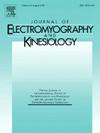痉挛偏瘫患者坐-站和站-坐运动时下肢关节反作用力。
IF 2.3
4区 医学
Q3 NEUROSCIENCES
引用次数: 0
摘要
目的:研究脑卒中痉挛性偏瘫患者坐立(Si-St)和站坐(St-Si)运动时髋关节、膝关节和踝关节反作用力(jrf)的特征,并探讨jrf与关节力矩的关系。方法:选取脑卒中痉挛性偏瘫患者13例和年龄相匹配的健康人13例。采用三维运动捕捉系统和力板采集Si-St和St-Si任务时的运动数据和地面反作用力。肌肉骨骼模型用于计算这些运动过程中髋关节、膝关节和踝关节的jrf和关节力矩。结果:脑卒中患者髋关节和膝关节的jrf (13.49 N/kg ~ 43.18 N/kg)高于健康组(15.81 N/kg ~ 23.00 N/kg)。此外,脑卒中患者在Si-St和St-Si运动时,髋关节和踝关节jrf与其关节力矩呈正相关。结论:早期康复策略应侧重于纠正体重分布和增强关节负荷的对称性。专注于减少关节力矩的干预措施,特别是髋关节和踝关节的干预措施,可能被证明对减轻Si-St和St-Si运动时痉挛性偏瘫卒中患者的下肢jrf有效。本文章由计算机程序翻译,如有差异,请以英文原文为准。
Lower limb joint reaction forces during sit-to-stand and stand-to-sit movements in stroke patients with spastic hemiplegia
Objective:
We investigated the characteristics of hip, knee, and ankle joint reaction forces (JRFs) in stroke patients with spastic hemiplegia during sit-to-stand (Si-St) and stand-to-sit (St-Si) movements and explored the relationship between JRFs and joint moments.
Methods:
Thirteen stroke patients with spastic hemiplegia and thirteen age-matched healthy subjects were recruited in this study. Three-dimensional motion capture system and force plates were employed to collect kinematic data and ground reaction forces during Si-St and St-Si tasks. Musculoskeletal modeling was used to calculate JRFs and joint moments of the hip, knee and ankle joints during these movements.
Results:
Those stroke patients exhibited higher JRFs (ranging from 13.49 N/kg to 43.18 N/kg) compared to the healthy group (ranging from 15.81 N/kg to 23.00 N/kg) in hip and knee joints. Furthermore, hip and ankle JRFs exhibited positive correlations with their joint moment in stroke patients during Si-St and St-Si movements.
Conclusion:
Early rehabilitation strategies should focus on correcting weight distribution and enhancing symmetry in joint loading. Interventions focused on reducing joint moment, particularly for hip and ankle joints, may prove effective in mitigating lower extremity JRFs in stroke patients with spastic hemiplegia during Si-St and St-Si movements.
求助全文
通过发布文献求助,成功后即可免费获取论文全文。
去求助
来源期刊
CiteScore
4.70
自引率
8.00%
发文量
70
审稿时长
74 days
期刊介绍:
Journal of Electromyography & Kinesiology is the primary source for outstanding original articles on the study of human movement from muscle contraction via its motor units and sensory system to integrated motion through mechanical and electrical detection techniques.
As the official publication of the International Society of Electrophysiology and Kinesiology, the journal is dedicated to publishing the best work in all areas of electromyography and kinesiology, including: control of movement, muscle fatigue, muscle and nerve properties, joint biomechanics and electrical stimulation. Applications in rehabilitation, sports & exercise, motion analysis, ergonomics, alternative & complimentary medicine, measures of human performance and technical articles on electromyographic signal processing are welcome.

 求助内容:
求助内容: 应助结果提醒方式:
应助结果提醒方式:


